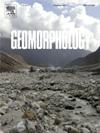Long term evolution of an escarpment in a tableland landscape (Serra Geral de Goiás, Brazil): Insights from in situ-produced cosmogenic nuclides
IF 3.1
2区 地球科学
Q2 GEOGRAPHY, PHYSICAL
引用次数: 0
Abstract
Topographic escarpments are striking geomorphic features shaping the Earth's surface, often forming distinct water divides in tectonically stable regions. This study presents a new analysis of the geomorphic evolution of the Serra Geral Escarpment in the State of Goiás, Central Brazil, using in situ-produced cosmogenic nuclides. The objective is to quantify Quaternary denudation rates associated with different geomorphic compartments of this regional-scale escarpment by measuring the concentrations of 10Be, 26Al, and 36Cl in river-borne sediments and bedrock outcrops. The results reveal three distinct denudation regimes: the summit surface of the Western Bahia Plateau (7.4 ± 0.2 m Myr−1), the pediplanation surface at the toe of the Serra Geral Escarpment (22.6 ± 0.6 m Myr−1), and the steep escarpment slopes (84.4 ± 3.8 m Myr−1). The significant influence of regolith burial and landslides on isotopic signatures is highlighted, underscoring the importance of accounting for these processes when interpreting cosmogenic nuclide data. Estimated escarpment retreat rates range from 30 to 90 m Myr−1 along active segments, while the southern region shows stabilization indicative of an advanced stage of landscape evolution. These findings demonstrate the complex interplay between geomorphic processes, lithology, and climate in shaping escarpments within continental interiors. Preliminary geomorphic evidence suggests that escarpment retreat and pediplanation at the glint's base may have initiated as early as the upper Miocene. This study establishes a framework for understanding tropical plateau erosion and offers insights into the evolution of similar escarpments worldwide.
求助全文
约1分钟内获得全文
求助全文
来源期刊

Geomorphology
地学-地球科学综合
CiteScore
8.00
自引率
10.30%
发文量
309
审稿时长
3.4 months
期刊介绍:
Our journal''s scope includes geomorphic themes of: tectonics and regional structure; glacial processes and landforms; fluvial sequences, Quaternary environmental change and dating; fluvial processes and landforms; mass movement, slopes and periglacial processes; hillslopes and soil erosion; weathering, karst and soils; aeolian processes and landforms, coastal dunes and arid environments; coastal and marine processes, estuaries and lakes; modelling, theoretical and quantitative geomorphology; DEM, GIS and remote sensing methods and applications; hazards, applied and planetary geomorphology; and volcanics.
 求助内容:
求助内容: 应助结果提醒方式:
应助结果提醒方式:


